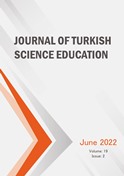Development of the High School Wave Optics Test
Research Article
Keywords:
Wave optics, test development, Rasch analysis, Conceptual UnderstandingAbstract
In this paper, we described the development of the High School Wave Optics Test (HSWOT). Firstly, 56 conceptual, multiple-choice items with a single correct answer, and three distractors were created. Next, we conducted an initial review of the items which resulted in reducing the item pool to 44 highest quality items. Validity evidence and feedback on the quality of these 44 items were collected through an expert survey and small-scale item try-out which included 3 subject-matter experts and 13 high school students, respectively. This process helped us to reduce our item pool to 30 technically improved conceptual items, which were eventually administered to 164 high-school students, from Kazakhstan. Finally, a Rasch analysis of the students' answers resulted in a 24 item scale for measuring conceptual understanding in high-school students. The item reliability proved to be good, person reliability was acceptable, and the difficulty of items was approximately person-independent. All distractors were chosen by at least 5% of students and 8 distracters were chosen by more than 35% of students. We could conclude that HSWOT may be effectively used for measuring conceptual understanding in advanced high-school physics courses and for identifying students' misconceptions in wave optics, in general.
